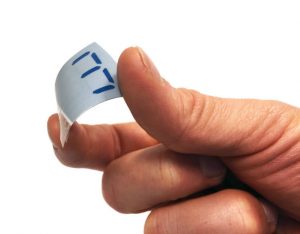Electrochromic technology is the key to low-cost simple displays, according to Swedish firm Rdot Displays.

According to the firm, it can mass-produce reflective flexible displays on plastic substrates without needing metal or ITO layers – by either sheet-to-sheet or roll-to-roll printing. Viewing angles are wide and contrast is high for reflective technology.
The underlying technology involves chemicals that change colour under the influence of electricity.
The visual change is monostable, needing 3V for under 100ms to set or clear a state, then gradually fading over hours – something Rdot refers to as ‘semi-bistable’, Truly bistable displays, like electrophoretic types from Eink, permanently stay in the state they are set to, for years if necessary.
Longer hold times can be obtained at the expense of a longer set/reset times.
It sees its monostable display being useful in devices that only need to portray information while they are being operated – a room thermostat, for example.
If the display needs to be read at any time, a 25ms refresh every 15 minutes will maintain full contrast, said Rdot.
Because response is slow, intended applications are simple alpha-numeric and other segmented displays with one electrical connection per segment. Simple matrix displays are possible, said the firm, but it is concentrating on the lowest cost segmented applications for now.
Its standard colour change is from light grey to dark blue and vice versa. “There two states are the natural colours of the electrochromic material that is used in the display,” said Rdot. “We have also made red-to-black and green-to-black displays and can also develop custom displays to match corporate colours or brands.” (see table below). Black and white displays are in the lab.
Power consumption is extremely low – see table below – with smaller segment areas consume less energy per cm2 than large segment areas, so segment size needs to be taken into account when making energy consumption calculations.
As a rough guide:
One full switch per day: 0.6μW/cm2
One full switch per hour: 10μW/cm2
One full switch per minute: 33.3μ/cm2
One full switch per second: 2mW/cm2
Driving voltages can be between 2V and 5V, with lower voltages consuming less power but switching slower.
The displays are not sensitive to UV, but without encapsulation there is a humidity dependence influences switching speed and fade time. A barrier with water vapour transmission rate of 10-2g/m2/day is usually sufficient to stabilise operation, said Rdot. “The display stack consists of organic layers including a plastic substrate, an electrochromic material, and an electrode for each segment. Additional layers such as graphical overlays, circuits, and barrier layers may be added if required.”
Operation is over -5 to +40°C, with no permanent damage observed over -20 to +80°C, “but the display driver needs to be modified”, said Rdot.
Lifetime depends mostly on the number of switching cycles undergone, with close to no degradation if the display is constantly in one state or the other. “For applications demanding more than 1000 switching cycles, it is recommended to keep the contrast approximately 20% below the maximum contrast by adjusting the switching time or voltage when switching from dark to bright state,” said Rdot. “With accurate driving, the lifetime will exceed 100,000 switching cycles.”
An in-house sheet-to-sheet production line is available for prototyping and pilot production up to several thousand display units per month, according to Rdot. Typical project lead time from sketch to delivered display is usually <3months.
A preferred partner is available for roll-to-roll mass production, and licensing can be arranged for very large volumes.
Several evaluation kits are available:
OK symbol (30 x 16mm2)
Numerals (25 x 22mm2)
One 7 segment number (30 x 40mm2)
Five square spots from 10 x 10 to 1 x 1mm2 (35 x 37mm2)
Seven bar-shaped spots (28 x 35mm2)
| Example energy consumption – for 3 x 7-segment digits | |
| Average segment area | 0.1cm2 |
| Number of segments | 21 |
| Total display segments area | 2.1cm2 |
| Driving voltage | 3V |
| Full switch energy for one segment | 0.06mJ |
| Full switch energy for all segments | 1.26mJ |
| Update speed | <100ms |
| Example Specifications | Red | Green | Blue |
| Contrast Ratio (Y/Y) | 1:8 | 1:11 | 1:7 |
| Contrast Ratio (ΔE) | 60.9 | 67.8 | 47.5 |
| L*a*b* bright state | [36.3, 55.8, 38.8] | [49.4, -54.1, 46.2] | [57, −3.7, −10.5] |
| L*a*b* dark state | [10.6, 19.3, -3.6] | [13.4, -29, -5.5] | [20.6, 10.2, −37.7] |
Source from:electronicsweekly

 Englisch
Englisch  Chinesisch
Chinesisch  Deutsch
Deutsch  Koreanisch
Koreanisch  Japanisch
Japanisch  Farsi
Farsi  Portuguese
Portuguese  Russian
Russian  Spanisch
Spanisch 





